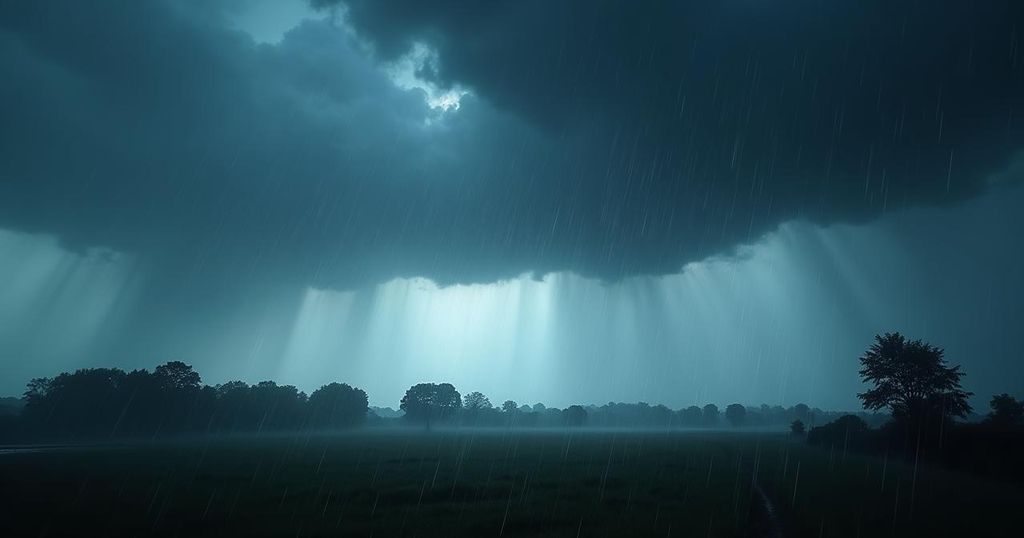The Historical Rainfall from Hurricane Helene: Analyzing 40 Trillion Gallons of Rainfall and its Implications
Meteorologists have reported that the Southeast United States received an astounding 40 trillion gallons of rain from Hurricane Helene and a preceding storm. This amount equates to catastrophic flooding with over 100 fatalities and surpasses the total water capacity of major reservoirs. Experts attribute this extreme weather event to a combination of climatic factors exacerbated by climate change, leading to a sharp increase in rainfall intensity and frequency.
In an unprecedented meteorological event, the Southeast United States experienced rainfall surpassing 40 trillion gallons due to the impact of Hurricane Helene and an accompanying rainstorm that preceded it. This staggering volume of precipitation is enough to fill the Dallas Cowboys’ stadium 51,000 times or Lake Tahoe just once, contributing to a deluge that, if localized to North Carolina, would equate to an inundation of approximately 3.5 feet (over one meter) deep, translating to over 60 million Olympic-sized swimming pools. Ed Clark, head of the National Oceanic and Atmospheric Administration’s National Water Center, expressed disbelief at the extent of this phenomenon, remarking, “That is an astronomical amount of precipitation. I have not seen something in my 25 years of working at the weather service that is this geographically large of an extent and the sheer volume of water that fell from the sky.” The catastrophic flood effects have claimed over 100 lives as reported by officials. Ryan Maue, a private meteorologist and former NOAA chief scientist, utilized precipitation data collected by satellites and ground observations within 2.5-mile by 2.5-mile grids. His calculations indicated that nearly 40 trillion gallons of rain had fallen across the eastern United States by Sunday, with approximately 20 trillion gallons originating from Hurricane Helene impacting states including Georgia, Tennessee, the Carolinas, and Florida. Clark independently confirmed Maue’s findings and emphasized that this figure may indeed be conservative, suggesting that up to two trillion gallons additional rainfall likely occurred, particularly in Virginia. Historically, prior to Hurricane Harvey in 2017, Clark noted, “I said to our colleagues, you know, I never thought in my career that we would measure rainfall in feet. And after Harvey, Florence, the more isolated events in eastern Kentucky, portions of South Dakota, we are seeing events year in and year out where we are measuring rainfall in feet.” Meteorologists have identified the combination of multiple storm systems contributing to the excessive rainfall, exacerbated by the elevation of mountain ranges that enhance moisture extraction from the atmosphere. North Carolina’s weather officials reported record measurements, including a staggering 31.33 inches recorded in the remote town of Busick and over two feet on Mount Mitchell. Climate experts note that such extreme weather events are becoming increasingly frequent, correlating with climate change. The atmospheric capacity to hold moisture increases by roughly four percent for every degree Fahrenheit of warming, and with global temperatures rising over two degrees since pre-industrial times, the implications for rainfall patterns are clear. Corbosiero and Dello’s analyses illustrate a troubling trend, as they assert that the impacts observed during Hurricane Helene are indicative of ongoing climate change. Preliminary research indicates that climate change may have increased rainfall by 50% in certain regions impacted by Helene in Georgia and the Carolinas. Dello firmly stated, “We’ve seen tropical storm impacts in western North Carolina. But these storms are wetter and these storms are warmer. And there would have been a time when a tropical storm would have been heading toward North Carolina and would have caused some rain and some damage, but not apocalyptic destruction.”
The article discusses the significant rainfall event that impacted the Southeast United States, primarily caused by Hurricane Helene and an associated rainstorm. It provides data on the extraordinary volume of rainfall, compares it to familiar landmarks for perspective, and examines the implications of climate change on these extreme weather phenomena. The feedback from meteorologists offers insights into how such weather patterns are evolving, with dire consequences for regions affected.
In summation, the recent torrential rains experienced in the Southeastern United States, attributed to Hurricane Helene and concurrent storm systems, highlight the alarming potential for catastrophic weather events exacerbated by climate change. The sheer volume of rainfall not only emphasizes the severity of the situation but also poses significant challenges for future weather resilience and disaster preparedness in vulnerable regions. Efforts to understand the interplay between climate change and the frequency of such extreme weather events are essential as societies strive to adapt and mitigate the impacts of an increasingly unpredictable climate.
Original Source: abcnews.go.com




Post Comment